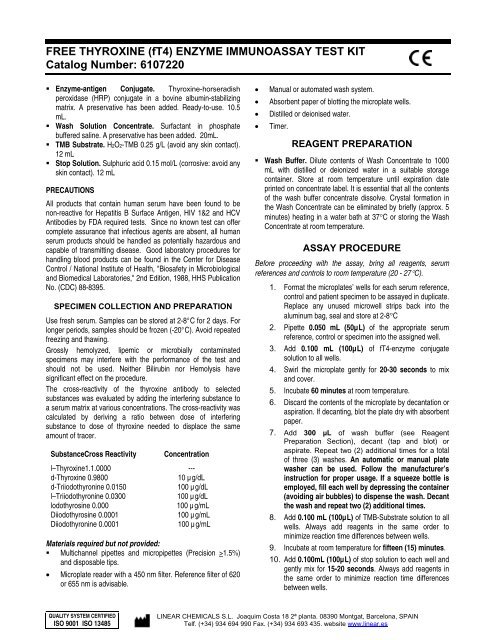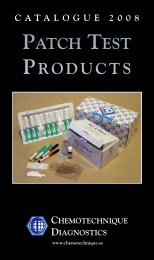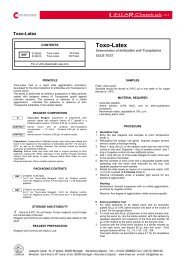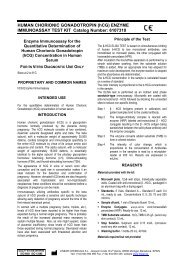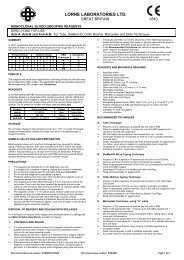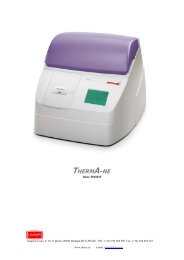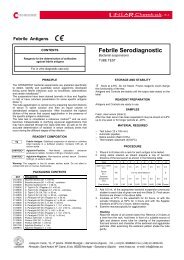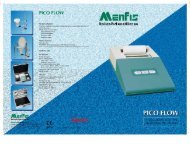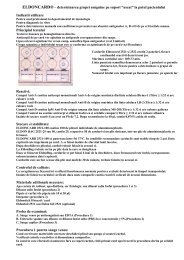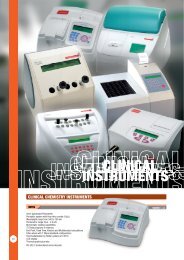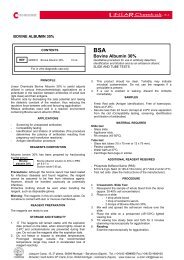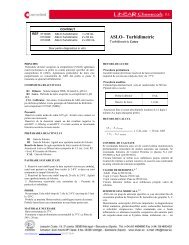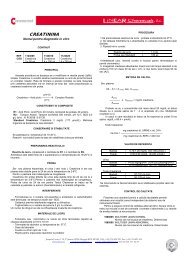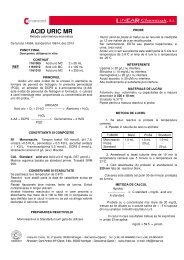FREE THYROXINE (fT4) ENZYME IMMUNOASSAY TEST ... - Linear
FREE THYROXINE (fT4) ENZYME IMMUNOASSAY TEST ... - Linear
FREE THYROXINE (fT4) ENZYME IMMUNOASSAY TEST ... - Linear
You also want an ePaper? Increase the reach of your titles
YUMPU automatically turns print PDFs into web optimized ePapers that Google loves.
<strong>FREE</strong> <strong>THYROXINE</strong> (<strong>fT4</strong>) <strong>ENZYME</strong> <strong>IMMUNOASSAY</strong> <strong>TEST</strong> KIT<br />
Catalog Number: 6107220<br />
• Enzyme-antigen Conjugate. Thyroxine-horseradish<br />
peroxidase (HRP) conjugate in a bovine albumin-stabilizing<br />
matrix. A preservative has been added. Ready-to-use. 10.5<br />
mL.<br />
• Wash Solution Concentrate. Surfactant in phosphate<br />
buffered saline. A preservative has been added. 20mL.<br />
• TMB Substrate. H2O2-TMB 0.25 g/L (avoid any skin contact).<br />
12 mL<br />
• Stop Solution. Sulphuric acid 0.15 mol/L (corrosive: avoid any<br />
skin contact). 12 mL<br />
PRECAUTIONS<br />
All products that contain human serum have been found to be<br />
non-reactive for Hepatitis B Surface Antigen, HIV 1&2 and HCV<br />
Antibodies by FDA required tests. Since no known test can offer<br />
complete assurance that infectious agents are absent, all human<br />
serum products should be handled as potentially hazardous and<br />
capable of transmitting disease. Good laboratory procedures for<br />
handling blood products can be found in the Center for Disease<br />
Control / National Institute of Health, "Biosafety in Microbiological<br />
and Biomedical Laboratories," 2nd Edition, 1988, HHS Publication<br />
No. (CDC) 88-8395.<br />
SPECIMEN COLLECTION AND PREPARATION<br />
Use fresh serum. Samples can be stored at 2-8°C for 2 days. For<br />
longer periods, samples should be frozen (-20°C). Avoid repeated<br />
freezing and thawing.<br />
Grossly hemolyzed, lipemic or microbially contaminated<br />
specimens may interfere with the performance of the test and<br />
should not be used. Neither Bilirubin nor Hemolysis have<br />
significant effect on the procedure.<br />
The cross-reactivity of the thyroxine antibody to selected<br />
substances was evaluated by adding the interfering substance to<br />
a serum matrix at various concentrations. The cross-reactivity was<br />
calculated by deriving a ratio between dose of interfering<br />
substance to dose of thyroxine needed to displace the same<br />
amount of tracer.<br />
SubstanceCross Reactivity<br />
Concentration<br />
l–Thyroxine1.1.0000 ---<br />
d-Thyroxine 0.9800<br />
10 µg/dL<br />
d-Triiodothyronine 0.0150<br />
100 µg/dL<br />
l–Triiodothyronine 0.0300<br />
100 µg/dL<br />
lodothyrosine 0.000<br />
100 µg/mL<br />
Diiodothyrosine 0.0001<br />
100 µg/mL<br />
Diiodothyronine 0.0001<br />
100 µg/mL<br />
Materials required but not provided:<br />
• Multichannel pipettes and micropipettes (Precision >1.5%)<br />
and disposable tips.<br />
• Microplate reader with a 450 nm filter. Reference filter of 620<br />
or 655 nm is advisable.<br />
• Manual or automated wash system.<br />
• Absorbent paper of blotting the microplate wells.<br />
• Distilled or deionised water.<br />
• Timer.<br />
REAGENT PREPARATION<br />
• Wash Buffer. Dilute contents of Wash Concentrate to 1000<br />
mL with distilled or deionized water in a suitable storage<br />
container. Store at room temperature until expiration date<br />
printed on concentrate label. It is essential that all the contents<br />
of the wash buffer concentrate dissolve. Crystal formation in<br />
the Wash Concentrate can be eliminated by briefly (approx. 5<br />
minutes) heating in a water bath at 37°C or storing the Wash<br />
Concentrate at room temperature.<br />
ASSAY PROCEDURE<br />
Before proceeding with the assay, bring all reagents, serum<br />
references and controls to room temperature (20 - 27°C).<br />
1. Format the microplates’ wells for each serum reference,<br />
control and patient specimen to be assayed in duplicate.<br />
Replace any unused microwell strips back into the<br />
aluminum bag, seal and store at 2-8°C<br />
2. Pipette 0.050 mL (50µL) of the appropriate serum<br />
reference, control or specimen into the assigned well.<br />
3. Add 0.100 mL (100µL) of <strong>fT4</strong>-enzyme conjugate<br />
solution to all wells.<br />
4. Swirl the microplate gently for 20-30 seconds to mix<br />
and cover.<br />
5. Incubate 60 minutes at room temperature.<br />
6. Discard the contents of the microplate by decantation or<br />
aspiration. If decanting, blot the plate dry with absorbent<br />
paper.<br />
7. Add 300 µL of wash buffer (see Reagent<br />
Preparation Section), decant (tap and blot) or<br />
aspirate. Repeat two (2) additional times for a total<br />
of three (3) washes. An automatic or manual plate<br />
washer can be used. Follow the manufacturer’s<br />
instruction for proper usage. If a squeeze bottle is<br />
employed, fill each well by depressing the container<br />
(avoiding air bubbles) to dispense the wash. Decant<br />
the wash and repeat two (2) additional times.<br />
8. Add 0.100 mL (100µL) of TMB-Substrate solution to all<br />
wells. Always add reagents in the same order to<br />
minimize reaction time differences between wells.<br />
9. Incubate at room temperature for fifteen (15) minutes.<br />
10. Add 0.100mL (100µL) of stop solution to each well and<br />
gently mix for 15-20 seconds. Always add reagents in<br />
the same order to minimize reaction time differences<br />
between wells.<br />
QUALITY SYSTEM CERTIFIED<br />
ISO 9001 ISO 13485<br />
LINEAR CHEMICALS S.L. Joaquim Costa 18 2ª planta. 08390 Montgat, Barcelona, SPAIN<br />
Telf. (+34) 934 694 990 Fax. (+34) 934 693 435. website www.linear.es


